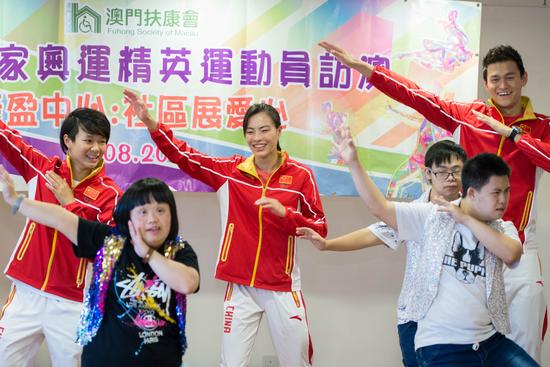Scholars: Traditional Chinese wisdom can guide social workers

Chinese Olympians who just returned from the Rio Olympic Games, dance with members of a rehabilitation center during their visit in Macau on Aug. 31, 2016.
For more than 100 years, the scope, goals and functions of modern social work have expanded to cover every corner of society—from communities, charities, schools and hospitals to places you may not expect, including corporations and prisons—said Xu Yongxiang, a professor of social work from the East China University of Science and Technology, during a high-level forum on Social Work Development in China held by Wuhan University from Aug. 25 to 26.
He pointed out that the scope of social work in China has been broadened from simply caring for the most disadvantaged and the marginalized groups to helping all people in need, adding that its function is not charity alone but also social management.
Wang Sibin, a professor from the Department of Sociology at Peking University, said social workers have come to realize that their role is not simply addressing current problems but preventing new ones from arising.
Tong Min, a professor of public affairs at Xiamen University, compared the two current models for social work praxis: the problem-solving model and the strengths perspective.
The strengths-based perspective has emerged as an innovative approach to social work that focuses on strengths, abilities and potential rather than problems, leading to the optimistic assumption that problems can generally be avoided through effective intervention, Tong said.
A solution-focused approach provides social workers with a more integrated and balanced way to help clients based on their strengths as well as problems. This method encourages social workers to teach clients how to apply a problem-solving method, so they can develop their own solutions, Tong said.
Li Yingsheng, a professor from the School of Sociology and Population Studies at Renmin University of China, said that a scientific summary of Chinese social work traditions and practices that exist in non-professional social services is an important way to construct a localized theoretical system of social work.
This approach combines the traditional means the Chinese people have commonly used to overcome difficulties—aid from relatives and friends—with several models that China’s party organizations and mass organizations have adopted to address the social and mental health problems of disadvantaged groups, Li said. Experience could be gained from the traditions of Chinese social work to provide professional social workers with localized approaches, methods and models in practice, Li added.
Wang emphasized that it is necessary to study the effects of culture and social consciousness on social work. In addition, he encouraged researchers to participate in more studies like the reform of the social security system, community development and other pressing problems, which will fuel social work practice as well as the theoretical development of the field.
Li added that the construction of a localized theoretical social work system will be a long process, which should critically draw on theoretical frameworks from Western countries, inherit traditional thoughts of social welfare, and closely integrate theory with social work practice in transitional China.
Ming Haiying is a reporter at the Chinese Social Sciences Today.

 PRINT
PRINT CLOSE
CLOSE